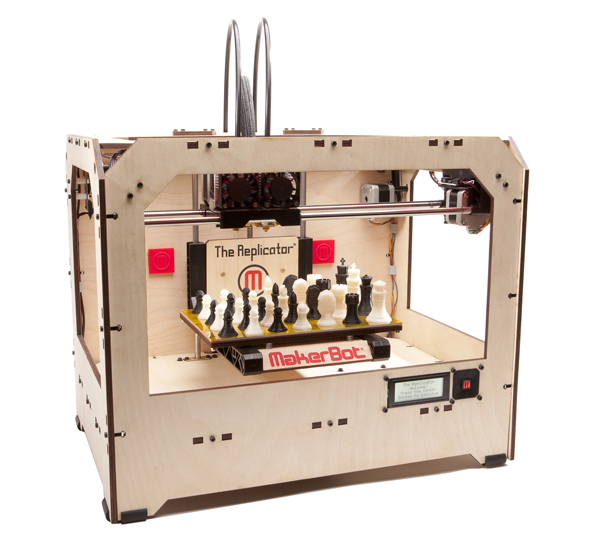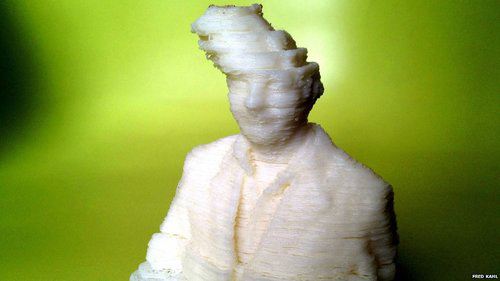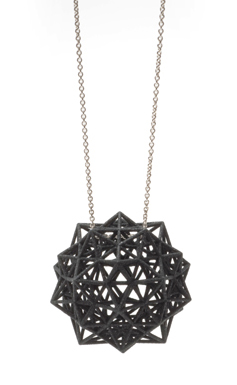If you want an article about how the 3D printer will change our world and usher in a New Industrial Revolution go elsewhere. There is no dearth—on the web, in the news, or in print—of literature that compares 3D printing to the second coming. As for me, I’m not sure whether we have really got to grips with previous revolutions in production, let alone any paradigm shifts in our present era. As with our reliance on the clear poetic rhetoric of Thomas Carlyle, John Ruskin, and William Morris to make sense of the Industrial Revolution, we are prone to trust the lyrical simplicity of words over the complex matter of material change.

Are we so in need of distraction that we force ourselves to think of a 3D-printed world, without even knowing where to purchase a 3D printer, what CAD (computer aided design) software to use, or even why we should wield these resin-spouting boxes to vie with the production centers of the world, with their indisputable economies of scale. Are we content to make wild claims for a technology that flatters our creative potential, giving us the chance to create pointless plastic knickknacks or one’s portrait in ceramic-style resin?
The hype of 3D printing obscures a more important discussion of how it is used as a tool. This attention to different types of use, and how different users respond to what a tool or piece of machinery can do, is a valuable way of negotiating the hype surrounding 3D printers, an approach to technology I argued for in an article I wrote for Design and Culture. In the world of jewelry, a focus on the types of engagement with the 3D printer helps establish qualitative difference between a range of practice, from the enthusiastic novice experimenting with a shop-bought RepRap to the trained designer using additive manufacture to produce artificial limbs and body parts to save lives.
3D Printing Is Nothing New
For industry and technology experts, the 3D printer is just one of a whole palette of tools used to make things. Those assembled at the V&A’s discussion “What Is the Future of 3D Printing?” which was held in September 2013 as part of the London Design Festival, were generally unconvinced that domestic 3D printing would radically alter the way things are made. Their attitude to the technology was a result of their familiarity with various forms of rapid prototyping and CNC (computer numerical control) milling, and they threw cold water over the idea of a new production paradigm driven by bedroom enthusiasts.
The experienced panel identified the particular strengths of 3D printing. The new technology is particularly good for producing prototypes and customizable design, one-off products that do not need an assembly line. Mark Miadownik, of UCL’s Material Library, praised the 3D printers ability to produce tailor-made body parts, say a hip replacement or a scaffold for a stem cell, as well as the convenience of 3D printers in replacing the broken bits of everyday domestic appliances and objects with spare parts that have long been out of stock. There seemed to be a sense that, within industry, 3D printing is just plain normal, a tool alongside any other with its particular strengths and weaknesses.
Domestic Difficulties
Prophets of a 3D future know these technologies have been around for a long while, but they see in their domestic use and accessibility, huge potential to alter conventions of production, a future well encapsulated by Brett Ryder’s cover illustration for The Economist’s special issue on 3D printing in April 2012. They foresee a future when technology allows the home to return to its pre- or proto-industrial state, the “electronic cottage” according to futurologist Alvin Toffler,[3] where large factories— concentrations of capital and labor—are no longer needed.

Yet these speculations overlook the simple fact that 3D printing is not easy. Even if relying on the generosity of designers who upload their CAD files online, 3D printing remains difficult. As journalist A. J. Jacobs notes in his article on 3D printing for the New York Times, “3D printing is surprisingly hard —a fact its advocates don’t dwell upon. So much can go wrong: the nozzle clogs, the machine overheats, the print pad tilts.”
The technology is still juvenile. It is having growing pains as shown by the Tumblr stream EPIC 3D Printing Fail that presents photographs of technical botches or glitches resulting from 3D printing. The technology is also not efficient compared to other forms of manufacture. Jacobs’s article also points out the huge amount of time it takes to make even the smallest of objects. Just imagine how long it would be to 3D print all those iPhone cases if it takes a day to make one plastic fork. Jacobs’s final conclusion is that to 3D print objects that work, let alone look good, requires bringing in individuals who know about the kit.

The presence of a company like Shapeways—with its highly trained staff and material resources— alerts us to the difficulty of 3D printing. It is perfectly feasible to imagine a 3D printer in more houses in the near future, but to produce anything of material substance requires time, skill, and money, resources that are often only available to a limited few.
Work for Jewelers
Shapeways, of course, represents a technical service that would not appeal as a career destination for most jewelers. Yet, the company shows how 3D printing requires skilled makers, designers, and artists to make sense of it. There is a huge demand for those who know how the tool works—its idiosyncrasies, its weaknesses, and its strengths. And, this is no mean task given the huge range of printers available, from RepRap machines, Z-Corp 650, ProMetal printers, and HD3000, CPX, and Objet Connex printers. Many of these are additive systems where resin is built up layer by layer, but there are also systems based on selective laser sintering where a laser is zapped through a big box of powder to produce objects, such as the EOS machines used by Shapeways. Jewelers, well accustomed to knowing tools inside out, will not be out of a job. Also, jewelers are not likely to be replaced by bedroom designers printing brooches from their RepRap so long as they attend to the question of materiality. Why is 3D printing chosen as a method? What does it bring to the object being made? How can we get beyond the hype of the tool?


The biggest problem with 3D-printed jewelry is that it looks like it is 3D printed. This has resulted in an increasingly anodyne aesthetic for 3D-printed objects. First of all, there is the smooth, matt resin surface that exposes the origins of 3D-printed jewelry and the lack of mixed materials within one piece. More problematic, however, is the register of forms that makers decide to 3D print are in danger of becoming predictable: the honeycomb, amoeba, or cell-like shapes on rings or brooches as seen in the work of Tasmanian jeweler Charles Wyatt or the large range of jewelry developed by Nervous System; the sharp geometric, crystalline angles seen in some of the work of American jewelers Arthur Hash, Gonçalo Campos, and Rachel Timmins; the computer aesthetics of Hot Pop Factory; and the intricate elaborate patterns 3D printers can achieve as epitomized by Joshua Harker’s arabesque skulls. In the allied field of ceramics, Micheal Eden’s Babel Vessel (2010) asserts its 3D-printed nature loudest of all, with a QR code there just in case we forget which century we are in.
This work does utilize the potential of additive manufacture, but they seem to draw their strength and notoriety from the rhetoric of the futurologists I touched on earlier. They are made to look like the technology from which they are made, and they rely on the fact that 3D printing is big news. The misunderstandings about the ease of use and revolutionary capability of 3D printers perpetuated by the press generates a market that associates 3D printing with cutting-edge design and fashion rather than aligning the technology with its industrial uses—as a way of producing prototypes, fittings, or customizable body parts that are 3D printed but often cast in other materials (their birthmarks as 3D-printed objects are erased in the process). Wearers of 3D jewelry, on the other hand, are less interested in 3D prototyping than in 3D production. They want the objects to expose their origins, to be able to say, “You know, this is 3D printed.”
Makers that use 3D printers often have an interest in contributing to this hype as it enlarges their market. You hear of makers citing the notion of the “Third Industrial Revolution” and spreading the idea that 3D printing can make an artist of anyone.[4] When the maker knows how difficult it is to work with 3D printers, how difficult it is to use Rhino or any other CAD software, is this a red herring? The narrative of de-skilling often acts as a convenient smokescreen to the limitations and difficulties of 3D printing.
Sooner or later, or maybe now—once the 3D printer is understood as a tool and not a rhetorical fantasy—audiences will not be so intrigued by 3D printing. The trick might suddenly become unimpressive, leaving a legion of makers with 3D-printed “one-hit-wonders.”
V&A Misfiring

For Defence Distributed and the regularly sunglassed Cody Wilson, the printable 3D gun seems like a remarkably successful stunt that has fed off the hype generated by the 3D printer. It is a stunt that has ensnared the acquisition team at the V&A with the lure that they are making an interesting, even controversial, intervention into the debate about accessible design. Tired with toys and trinkets, senior curator of contemporary exhibits at the V&A Kieran Long thought that a 3D-printed gun would set the cat among the pigeons, revealing the true social and cultural impact of disseminated production—the fact that everyone could make a gun.[5] I think the embarrassment will come later, when they realize they’ve partially bankrolled a hobbyist’s desire to put a gun in everyone’s pocket, “to defend the civil liberty of popular access to arms as guaranteed by the United States Constitution … through facilitating global access to, and the collaborative production of … 3D printing of arms.”[6]

Roux-Fouillet’s work emphasizes the processes that went into making it, revealing the full power and violence of the weapon. The 3D-printed gun, by comparison, pays little attention to the important material parts of its (object) biography that take place on either side of its exhibition at the V&A. Both the initial complexity of making, designing, and then assembling all the parts of the 3D gun that happens before the exhibition and the violence of the end product are concealed by the rhetorical smokescreen of technological progress. Once again, hype takes the limelight at the expense of material understanding.
Conclusion
The comparison between Wilson and Roux-Fouillet illuminates different attitudes to technology that help cut through the hype associated with 3D printing. One operates in the realm of imagination: the idea that everything, even a gun, can be put into the hands of everyone. This stunt relies on the illusory rhetorical notion of technological perfection and the politics of frontier-man libertarianism, and obscures the technological sophistication, difficulty, and messy materiality of 3D printing. Roux-Fouillet’s project, on the other hand, unveils the material impact of tools through tampering or hacking. Although nothing to do with 3D printing, the modified shotgun is comparable to makers who modify and hack 3D printers. One example is the Stratigraphic Manufactury project set up by Belgian design studio unfold, in which invited participants from across the globe introduced their own local ceramic materials to the syringe and nozzle of a modified RapMan 3D printer bought as a kit from bits and bytes. This focus on the materiality of this complex tool, its potential and limitations, will no doubt provide jewelers with a steady stream of work, opportunity, and debate well into the future.
[1] Clay Shirky, Here Comes Everybody (London: Allen Lane, 2008); Charles Leadbeater We-Think: The Power of Mass Creativity (London: Profile, 2008); and David Gauntlett, Making is Connecting (Cambrdige: Polity, 2011).
[2] Alvin Toffler, The Third Wave (London: Pan Books, 1981).
[3] Alvin Toffler, The Third Wave, 204-217.
[4] Joshua Harker, ‘Making the Unmakable – The 3rd Industrial Revolution’. Tedx talk Binghampton University, 2013.
[5] Vanessa Thorpe, ‘3D printing store set for Oxford Street as V&A displays printed gun’ Guardian (15 September 2013). http://www.theguardian.com/technology/2013/sep/15/3d-printing-store-oxford-street
[6] ‘About DD’ from Defence Distributed’s website (http://defdist.org).




